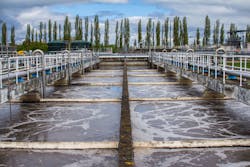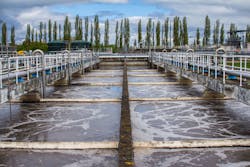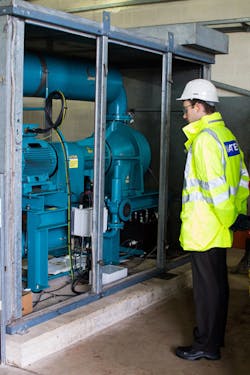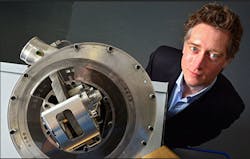Why Innovation is Bubbling Under
As utilities move to drive down energy costs, innovation in aeration technology continues to move apace in the UK. This article looks at some of the innovation taking place and how utilities adopting new technologies are seeing financial and environmental benefits.
By Claire Smith and Natasha Wiseman
It is now more than 100 years since Manchester chemists Edward Ardern and William Lockett pioneered activated sludge. This method of using micro-organisms to break down sewage is still an essential part of wastewater treatment - but delivering air to those micro-organisms is hugely energy-intensive and increasingly expensive.
As water utilities try to drive down costs - with some looking seriously at becoming energy neutral - a host of radical ideas have emerged for making aeration more efficient.
Paul O'Callaghan, CEO of BlueTech Research says the high cost of aeration will inevitably drive innovation: "Basically bacteria need to eat food and to breathe in air. They take in oxygen and absorb food and then convert it to carbon dioxide.
"But oxygen does not really dissolve very well in water," O'Callaghan points out. "And air itself is only 21% oxygen. So we need to push a lot of air into the water to dissolve a small amount.
"In any city, about 50% of the civic energy bill goes on providing water services," says O'Callaghan. "When you break that down, 50% of that is moving water, 25% of that is wastewater treatment - half of that is aeration."
Aeration and energy
New technologies are being developed which may, in time, radically alter the aeration process.
Tony Conway, visiting professor at the University of Sheffield and a former director of UK company United Utilities, says aeration and energy use is one of the hot topics in the water industry.
"It is a massive question and it's a huge issue," he says. "Most people are surprised at just how much energy water companies use."
More and more water companies are attempting to become ‘energy neutral' by using more anaerobic systems, or by recycling energy. Plants in Denmark, Australia and the US have already achieved the holy grail. Germany, France, the Czech Republic and India also boast plants that are close to becoming energy neutral. Some serious projects on a variety of energy-saving approaches are going on in the UK too. However, the cradle of Arden and Lockett's activated sludge revolution also has a legacy of plants that can be decades old - which poses a different set of problems.
Upgrades
Prof Conway says many utilities in the UK had made huge energy savings by upgrading more mature plants, replacing paddles, which stir in air from above, with fine bubble diffusers, which pump it up from below. However, retrofitting can be costly, time consuming and not always practical.
"We still have a lot of surface aeration plants," Conway observes. "But there is a lot that can be done with existing plant to optimise operation. It is far harder to re-invent the set-up."
Much work is also being done on making aeration itself more efficient - particularly by making bubbles finer. Smaller bubbles have a greater surface area, which diffuses more oxygen.
In terms of the future of biological treatment, Prof Conway says there was currently some exciting work developing pre-selected micro-organisms which could potentially speed-up the activated sludge process.
Steve Kaye, head of innovation at Anglian Water, says utilities are well aware of the issue but have to work with the plants and processes they have.
"Activated sludge may be 100 years old but it is quite an effective process," he says. "At the time we built a lot of our plants energy was much cheaper. In the last 10-15 years, energy started to become a lot more expensive. But it is difficult to get rid of the plants we have."
Micro bubbles
One of the ways Anglian has been cutting energy bills from aeration is to put in smart control systems - which monitor energy use minute-by-minute.
"We are trying to measure in real-time how well we are treating wastewater", says Kaye. "We have also introduced a stricter maintenance regime to ensure the bubbles being produced by the air-diffuser are as small as possible."
Anglian has also worked with Mapal Green Energy, the Israeli company which has developed a floating fine-bubble aerator which can work alongside existing systems.
At its Stanbridgeford plant, which was struggling with extra loads, Anglian introduced Mapal's floating aerator to increase the efficiency in its existing works. "We improved the performance without having to build more structures," he says.
As head of innovation, Kaye keeps an eye on the latest technology. "One of the really exciting things on the horizon is micro-bubbles. We are looking at some real cutting-edge innovation around this."
Kaye also believes that, in the longer term, rising energy costs will force utilities to look at introducing radical low-energy alternatives to aeration - such as trickling filters, reed beds and lagoons.
He is also excited about research currently going on at Cranfield University, which is using algae activated by light to treat wastewater.
Monitoring benefits
John Leonard, innovation and optimisation manager at Wessex Water, says monitoring energy use and efficiency at poorly performing plants has already brought huge benefits.
"What we have been doing is looking at the more inefficient processes, which are often the ones that have been around the longest," he says. "In some cases, we have introduced new control systems which have made the plants more energy efficient. In others we have undertaken a complete retrofit, replacing surface diffusers with fine bubble diffusers."
At Wessex Water's Weymouth plant, which serves a population equivalent of 30,000, replacing the old surface aeration with fine-bubble aeration led to a 20% reduction in energy costs.
Changes to the financial regulation of UK water companies means they are now targeted with calculating combined capital and operational expenditure (totex) of new projects - which should make it easier for water companies to introduce this sort of radical refit - provided utility managers can make the case that the new plant will save money and will last. "Evolution not revolution is usually the way to go," says Leonard.
At Severn Trent Water, savings of 20% were achieved at a plant in Worcester, which replaced existing blowers with a new kind of low-energy air-compressor pioneered by Coventry manufacturer Lontra. The utility, which spends £9 million a year on energy, says the Lontra blade compressor is a "game changer."
Efficiency measurement
When it comes to measuring the efficiency of existing aeration systems, Kevin Poole, principal consultant of the wastewater treatment team at WRc is one of the UK's leading experts.
WRc, a centre for water innovation research in Swindon, UK, has been working with researchers from Cranfield University in Hertfordshire on a technique for using infrared imaging systems which were originally developed for use in the nuclear industry.
Poole believes the high cost of aeration will see more wastewater treatment works adopting anaerobic systems - particularly industrial works that have a rich quality of effluent. He also believes we may see an increase in pre-treatments which will reduce the amount of work the activated sludge has to do. However, he believes the vagaries of the UK climate will prevent any widescale move away from activated sludge there: "It is likely in the UK we will always need aeration."
Use of membranes
Aeration does not necessarily need bubbles - according to Wayne Byrne, chief executive of Oxymem in Ireland, which has developed a cage-based oxygen delivery system.
The technology originated in research carried in University College Dublin by Dr Eoin Casey and Dr Eoin Syron, who patented their discovery in 2007.
"What we do is use hollow-fibre silicon membranes. These dense membranes allow us to create a fixed-film, allowing the bacteria to grow on our membrane," says Byrne. "The membrane is permeable the oxygen goes directly across to the bacteria. Because we don't waste the oxygen we can do that is a way that is cost effective."
Oxymem went into manufacture in 2014 and currently employs 42 people, but business is growing. The company sold seven units last year - the biggest to Severn Trent Water for its Minworth wastewater treatment works. Able to treat enough for a population equivalent of 500, the Membrane Aerated Propofilm Reaction (MAPR) at Minworth is currently the biggest in the world. However, the company, which has customers in Sweden, Spain and the US, is about to deliver an MAPR which is twice the size.
Hot topic
There is certainly no shortage of new ideas when it comes to aeration. As well as cage-based aeration, floating bubble diffusers and pre-selected bugs, there is also new research taking place into deep shaft aeration - where bubbles are dissolved under pressure in wells 100m deep.
In operations, the work is more about monitoring existing plant, working out where energy is wasted and finding ways to refine the process of aeration to make sure the bubbles are delivering as much oxygen as possible.
In the UK, the introduction of the new totex regulatory environment will mean it will be easier to invest in energy saving schemes.
BlueTech's O'Callaghan believes we are in for some big changes.
"With water plants in Denmark, Australia and the United States already energy neutral we have seen it can be done," he says. "I believe over the next ten years there will be a big shift in that direction in water plants around the world."
"If you look at the bigger picture - in traditional aeration you are using energy to get rid of energy," O'Callaghan observes. "There is energy trapped in wastewater and yet you are using energy to break it down. I see this as a big opportunity."
In the UK alone, there are an estimated 10,000 water treatment plants - some of which were originally built in Victorian times.
While Arden and Lockett's basic system is still one of the cornerstones of sewage treatment, both the cost of energy and the desire to become energy neutral will inevitably drive innovation.
Clair Smith and Natasha Wiseman are from WiseonWater, a technical communications company for the water industry. For more information, email: [email protected].
More Water & WasteWater International Archives Issue Articles






